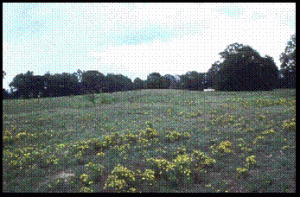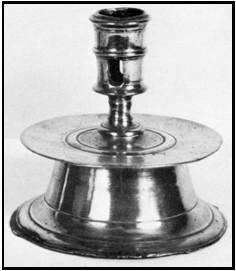Candlesticks of the Conquistadors: Rare Finds in Alabama
by Caleb Curren
Contact Archeology Ink
Several years ago, prior to current laws regarding human remains, collectors at site 1Ds1 found a sixteenth century brass candlestick. The site is located in the central portion of the state of Alabama (fig. 1) in a large, relatively narrow bend of the Alabama River. The candlestick was found on the northern end of the site, about 150 yards from the riverbank.

The brass candlestick (fig. 2) is generally shaped like an automobile wheel, a pulley roller, or a capstan used on early sailing ships, hence the name “capstan style candle stick.” The actual candleholder is attached atop the base. The bottom of the base is approximately 6 inches in diameter. The entire artifact is approximately 5 and 1/2 inches in height.

Figure 2: 16th Century Candlestick from Central Alabama Approx Height: 5 3/4 inches
The candlestick was found in an aboriginal burial pit, oval in shape and measuring approximately 6 feet in length and 3 feet in width. The candlestick was laying on its side approximately 4 inches from the top of the skull of the burial. The skeletal remains were found at about 3 feet below the present ground surface. The burial was extended on the back with the cranium pointing to the north. No data is available on the skeletal remains, which were in a good state of preservation. Other than the candlestick, the pit fill was reported as containing approximately 3 shell tempered, incised pottery sherds and several small chert flakes. Beneath the burial pit was culturally sterile, yellow sand.
Two other aboriginal burial pits were found within 6 to 10 feet of the one containing the candlestick. One of these was an urn burial and one was a bundle burial with several small shell beads. All three burials were associated with daub that may have been part of an aboriginal structure. Two Mississippian Period archeological phases are known from the site, Furman Phase and Alabama River Phase which date from approximately 1450-1650 AD (Curren 1984, 1992; Cottier 1970).
Collectors found another comparable 16th century brass, capstan style candlestick (fig. 3) in the 1980’s in the Mobile River Delta at site 1Ba296. Archeological field data is not available for the candlestick due to the indiscriminant methods used by the collectors. Generally, it was found with an impressive array of Bottle Creek/Bear Point Phase ceramic vessels, numerous high status objects of stone and shell, and other sixteenth century European artifacts. The European objects included: a brass pail, iron rifle barrel, iron ladle, sword, lance or pike head, knife, iron bridle and cheek plate, mule shoe, reworked iron kettle fragment, iron trade axe, wrought iron chisel, iron chisel or wedge fragment, fragmentary iron sickle, iron spikes, unidentified oxidized iron artifacts, chevron beads, turquoise blue glass beads, and a European manufactured earthenware ear spool, probably from a Columbia plain olive jar (Stowe et al. 1982; Stowe 1985; Fuller 1985; Curren 1992, Little & Curren 1990).

Figure 3: 16th Century Candlesticks from Southwest Alabama
Both candlesticks are comparably similar to 16th Century heirloom candlesticks from Europe (fig. 3) The two Alabama candlesticks are unique in North American archeology and are extremely important as clues in our understanding of movements of early Spanish armies and colonists through the Southeast. We are continuing to study these two unique candlesticks as to their date range, country of origin, the particular Spanish expedition that left them, and the lifeways of the aboriginal peoples buried with them.
Acknowledgments: Thanks to Charlie Clark, Ned Jenkins, and Reverend Oscar Lipscomb for their help in completing this article.

Figure 4: 16th Century Spanish Candlestick Heirloom from Europe Approx. Height 5 and 3/4 inches
Cottier, John W.
1970 The Alabama River Phase: A Brief Description of a Late Phase in the
Prehistory of South Central Alabama. Report to the National Park Service.
Curren, Caleb
1984 The Protohistoric Period in Central Alabama. Alabama-Tombigbee Regional Commission. Camden, Alabama.
1992 Archeology in the Mauvila Chiefdom: Native and Spanish Contacts during the Soto and Luna Expeditions. The Mauvila Project of the Mobile Historic Development Commission.
Fuller, Richard S.
1985 The Bear Point Phase of the Pensacola Variant: The Protohistoric Period in Southwest Alabama. The Florida Anthropologist 38:1-2.
Little, Keith J., and Caleb Curren
1990 Conquest Archaeology of Alabama. (in) Columbian Consequences 2.
David Hurst Thomas (ed.). Smithsonian Institution Press.
Stowe, Noel R.
1985 The Pensacola Variant and the Bottle Creek Phase. The Florida
Anthropologist 38(1-2).
Stowe, Noel R., Richard S. Fuller, Amy Snow, and Jennie Trimble
1982 A Preliminary Report on the Pine Log Creek Site (1Ba462).
Report on file, University of South Alabama.
- Article
-
Several years ago, prior to current laws regarding human remains, collectors at site 1Ds1 found a sixteenth century brass candlestick. The site is located in the central portion of the state of Alabama (fig. 1) in a large, relatively narrow bend of the Alabama River. The candlestick was found on the northern end of the site, about 150 yards from the riverbank.

The brass candlestick (fig. 2) is generally shaped like an automobile wheel, a pulley roller, or a capstan used on early sailing ships, hence the name “capstan style candle stick.” The actual candleholder is attached atop the base. The bottom of the base is approximately 6 inches in diameter. The entire artifact is approximately 5 and 1/2 inches in height.

Figure 2: 16th Century Candlestick from Central Alabama Approx Height: 5 3/4 inches
The candlestick was found in an aboriginal burial pit, oval in shape and measuring approximately 6 feet in length and 3 feet in width. The candlestick was laying on its side approximately 4 inches from the top of the skull of the burial. The skeletal remains were found at about 3 feet below the present ground surface. The burial was extended on the back with the cranium pointing to the north. No data is available on the skeletal remains, which were in a good state of preservation. Other than the candlestick, the pit fill was reported as containing approximately 3 shell tempered, incised pottery sherds and several small chert flakes. Beneath the burial pit was culturally sterile, yellow sand.
Two other aboriginal burial pits were found within 6 to 10 feet of the one containing the candlestick. One of these was an urn burial and one was a bundle burial with several small shell beads. All three burials were associated with daub that may have been part of an aboriginal structure. Two Mississippian Period archeological phases are known from the site, Furman Phase and Alabama River Phase which date from approximately 1450-1650 AD (Curren 1984, 1992; Cottier 1970).
Collectors found another comparable 16th century brass, capstan style candlestick (fig. 3) in the 1980’s in the Mobile River Delta at site 1Ba296. Archeological field data is not available for the candlestick due to the indiscriminant methods used by the collectors. Generally, it was found with an impressive array of Bottle Creek/Bear Point Phase ceramic vessels, numerous high status objects of stone and shell, and other sixteenth century European artifacts. The European objects included: a brass pail, iron rifle barrel, iron ladle, sword, lance or pike head, knife, iron bridle and cheek plate, mule shoe, reworked iron kettle fragment, iron trade axe, wrought iron chisel, iron chisel or wedge fragment, fragmentary iron sickle, iron spikes, unidentified oxidized iron artifacts, chevron beads, turquoise blue glass beads, and a European manufactured earthenware ear spool, probably from a Columbia plain olive jar (Stowe et al. 1982; Stowe 1985; Fuller 1985; Curren 1992, Little & Curren 1990).

Figure 3: 16th Century Candlesticks from Southwest Alabama
Both candlesticks are comparably similar to 16th Century heirloom candlesticks from Europe (fig. 3) The two Alabama candlesticks are unique in North American archeology and are extremely important as clues in our understanding of movements of early Spanish armies and colonists through the Southeast. We are continuing to study these two unique candlesticks as to their date range, country of origin, the particular Spanish expedition that left them, and the lifeways of the aboriginal peoples buried with them.
Acknowledgments: Thanks to Charlie Clark, Ned Jenkins, and Reverend Oscar Lipscomb for their help in completing this article.

Figure 4: 16th Century Spanish Candlestick Heirloom from Europe Approx. Height 5 and 3/4 inches
- References
-
Cottier, John W.
1970 The Alabama River Phase: A Brief Description of a Late Phase in the
Prehistory of South Central Alabama. Report to the National Park Service.
Curren, Caleb
1984 The Protohistoric Period in Central Alabama. Alabama-Tombigbee Regional Commission. Camden, Alabama.
1992 Archeology in the Mauvila Chiefdom: Native and Spanish Contacts during the Soto and Luna Expeditions. The Mauvila Project of the Mobile Historic Development Commission.
Fuller, Richard S.
1985 The Bear Point Phase of the Pensacola Variant: The Protohistoric Period in Southwest Alabama. The Florida Anthropologist 38:1-2.
Little, Keith J., and Caleb Curren
1990 Conquest Archaeology of Alabama. (in) Columbian Consequences 2.
David Hurst Thomas (ed.). Smithsonian Institution Press.
Stowe, Noel R.
1985 The Pensacola Variant and the Bottle Creek Phase. The Florida
Anthropologist 38(1-2).
Stowe, Noel R., Richard S. Fuller, Amy Snow, and Jennie Trimble
1982 A Preliminary Report on the Pine Log Creek Site (1Ba462).
Report on file, University of South Alabama.